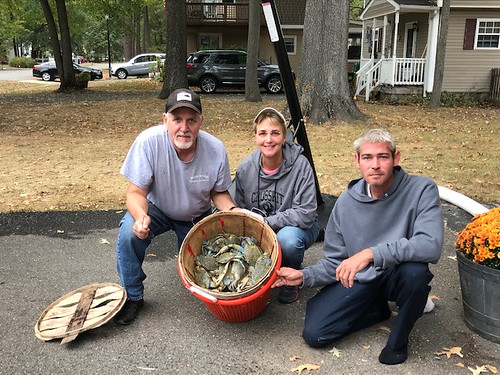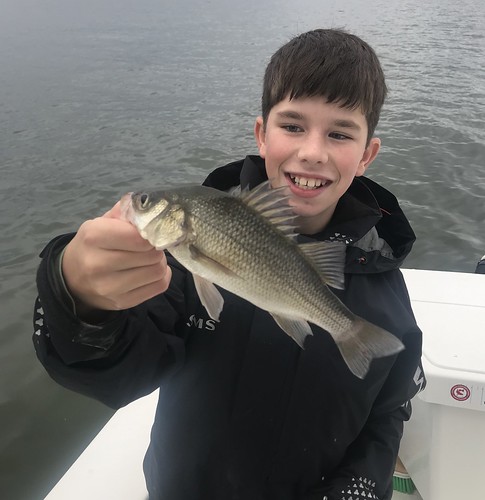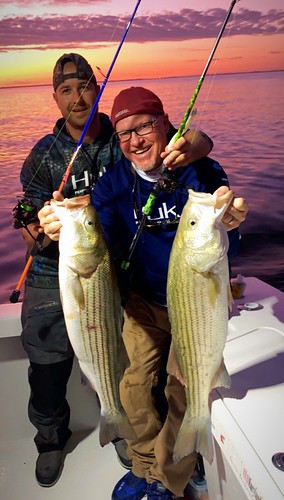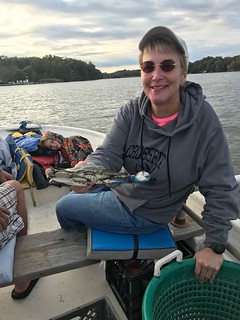Maryland Fishing Report – Oct. 16

Photo courtesy of Jim Livingston
Without a doubt we are now in a fall weather pattern, and those sunny days will become less and less frequent. Some are taking advantage of these remaining warm days and catching the last of the Chesapeake Bay’s summer bounty of blue crab.
Forecast Summary: Oct. 16 – Oct. 22:
The persistent north winds will continue to mix Bay waters from Wednesday through Friday. Surface water temperatures continue to drop and fish have lots of cooler, more oxygenated waters to roam. Rivers will cool faster than the Bay, so fish will move out of the rivers as they follow baitfish.
While water temperatures are uniform from surface down to the “Don’t Fish Below This Depth” line, focus on the shallower prime habitat areas during low light hours and deeper areas during the day. As always, make sure to focus on moving water periods for best results. Bay surface salinities are largely back to normal conditions.
Don’t Fish Below This Depth lines as determined by oxygen conditions — which are expected to continue improving — are as follows: State line up to Point Lookout, 45 feet; Point No Point up to the Gooses, 25 feet; Little Choptank up to Choptank River, 25 feet; Bloody Point, 25 feet; Bay Bridge, 25 feet; Swan Point, 21 feet; and from Still Pond up to the Susquehanna Flats, adequate oxygen to the bottom. Most tributary and adjacent waters have suitable oxygen to bottom except the Patapsco River, Ragged Point, Eastern Bay and Little Choptank, all at 25 feet; the Magothy River, 11 feet; and South River, 8 feet.
Expect reduced water clarity from algal blooms on the mainstem of the Bay from the Chester River down to the Virginia state line, and on the Potomac River from Colonial Beach down near Point Lookout. To see the latest images from NOAA, check “Eyes on the Bay Satellite Maps.”
Bay water temperatures have dropped to 68 degrees except for the lower Potomac at 69 degrees. Water temperature at Little Falls has dropped to 66 degrees. Expect normal flows from most of Maryland’s rivers and streams this week. However, both the Susquehanna and Potomac rivers are running below average. There will be above average tidal currents through Saturday as a result of the recent full moon.
For the full weekly fishing conditions summary and more detailed and up-to-date fishing conditions in your area of the bay, be sure to check out Click Before You Cast. You can now get regular updates on Maryland’s waters and the creatures that call them home sent to your inbox with our new Eyes on the Bay newsletter. Sign up online.
The Conowingo Dam is back on a midday power generation schedule. The best fishing at the dam pool has been at first light in the morning, for those casting topwater lures or swimshads as close to the turbines as possible. The striped bass action continues down the river and to the drop-off edges of the Susquehanna Flats. Early morning and late evening hours tend to provide the best action.
There are a lot of large flathead and blue catfish holding in the dam pool and they can be caught by casting jig heads with strips of fresh cut bait. In the lower part of the river and channels below the mouth of the river, bottom rigs baited with fresh cut bait, clam snouts, and fresh chicken breast are catching a mix of flathead, blue and channel catfish.
Those out searching the Bay and tidal river waters need to keep watch for floating logs and other debris from last weekend’s extreme high tides. Striped bass are being found in a variety of locations, mostly centered near structure and suspended over the 7-foot and 9-foot shoals, Tea Kettle Shoals, the channel edge from Podickory Point to the mouth of the Magothy, the lower Patapsco River, the Key Bridge, and channel edges at the mouth of the Chester River.

Nick Long is all smiles with this nice white perch he caught while fishing with his dad. Photo by Travis Long
Jigging has been popular at these locations, trolling has been effective, and some are continuing to live-line spot and small white perch. Breaking fish and slicks are being spotted, which are mostly small striped bass working on bay anchovies, but larger striped bass can be found holding close to the bottom and caught with large soft plastic jigs. Casting topwater lures during early morning and late evening hours has also been an effective way to target striped bass in the lower sections of the region’s tidal rivers. Anglers that are still live-lining are reminded that they must use circle hooks. Check our website and video for more information on circle hooks and careful release.
White perch are providing plenty of entertainment in the tidal rivers and some of the shoal areas. As water temperatures decline in the tidal rivers and creeks, white perch are feeling the urge to move to deeper waters in the lower sections of the tidal rivers. There is still some light-tackle action to be had along some of the deeper shorelines during the morning and evening hours for those using small spinnerbaits and jigs. Others are fishing deeper with bottom rigs baited with pieces of bloodworms or grass shrimp.
Nothing lasts forever, and it is not surprising that last week’s Northeaster has caused most of the Spanish mackerel that were spread throughout the region to begin heading south. Most of the breaking fish that are being encountered this week are made up of small striped bass and bluefish. Larger striped bass can be found lurking close to the bottom underneath the surface action and jigging with large soft plastic jigs is a good way to target them. Large striped bass can also be found suspended along channel edges.

Justin Beam and Jessie Clark are having a good time while jigging for large striped bass. Photo by Travis Long
Thomas Point continues to be the main focus of those wishing to live-line spot for striped bass, which are suspended along the channel edge there. Most agree that there is a high percentage of sub-legal striped bass holding there but legal fish are being caught. Anglers that are still live-lining are reminded that they must use circle hooks. Check our website and video for more information on circle hooks and careful release.
The early morning and evening topwater bite along various shoreline areas continues to improve. Prominent points and old rip rap or breakwaters are often good places to target. Trolling bucktails along the outside edges of these areas where the waters drop off can also be a good tactic. Water temperatures are holding at about 65 degrees in the tidal rivers.
Fishing for white perch continues to be a fun opportunity in tidal rivers and creeks. There is still plenty of action near structure such as piers in some of the deeper waters. Jigging with small jigs and spinnerbaits near structure is a good way to fish but it is hard to beat a simple one-hook bottom rig baited with pieces of bloodworm or grass shrimp. Channel catfish are common in the upper sections of most of the tidal rivers.
The area of the Middle Grounds may be the last best chance for catching Spanish mackerel before they leave Maryland waters on their trek to southern waters. Breaking fish are being spotted along channel edges as schools of bay anchovies are being swept along by swift currents. A mix of small striped bass and bluefish, with a few Spanish mackerel zipping through the action, are feeding on the hapless bay anchovies.
Casting metal jigs into the surface action is a fun way to fish whether you are targeting bluefish or Spanish mackerel — it all depends on the speed of your retrieve. Keeping a close eye on depth finders may reveal some rather heavy blips, indicating large red drum are holding close to the bottom underneath the surface action. Jigging with large spoons or soft plastic jigs are a great way to get in on some fun catch-and-release action. Be sure not to overlook surface slicks.
Targeting striped bass by live-lining has been a draw in the lower Potomac along the steep channel edge between St. Georges Island and Piney Point. There tends to be a high percentage of sub-legal striped bass in the mix. Bluefish can be pesky at times but fortunately there are plenty of small spot to be found for bait in the tidal rivers. Anglers that are still live-lining are reminded that they must use circle hooks when live-lining. Check our website and video for more information on circle hooks and careful release.
Fishing for white perch in the tidal rivers remains good this week for those fishing over oyster bars and hard bottom. Most are using pieces of bloodworms on bottom rigs but grass shrimp or pieces of white shrimp that are showing up in the lower Bay make good baits.

Paula Jenkins holds a whopper of a crab for the camera. Photo by Jim Livingston
Speckled trout are providing some exciting shallow-water fishing opportunities along the marsh edges and stump fields of the Eastern Shore. Casting topwater lures or swimshads is a good tactic or jigging with medium-sized soft plastics along channel edges are good ways to get in on the action.
Blue catfish reign supreme this time of the year in several of the region’s tidal rivers. Cooler water temperatures have kicked activity levels of blue catfish into overdrive in the Nanticoke, Potomac and Patuxent rivers. Fishing along channel edges with fresh cut bait or clam snouts is accounting for excellent catches of medium-sized blue catfish that are perfect for eating fresh or freezing for future meals.
Time is running out for those wishing for a last batch of large heavy crabs. Cooler water temperatures have many crabs holding in slightly warmer shallow waters, where there is also a high percentage of sooks and small crabs. Targeting waters as deep as 15 inches is accounting for the best catches of the larger crabs that are beginning to think about migrating to areas in the lower sections of the tidal rivers where they will wait out the winter months.
The fall trout stocking program is shifting into a higher gear this week as several central and western region waters were stocked, with more to come. The Patapsco River recently received a healthy stocking of rainbow trout as one example. Be sure to check the trout stocking website for the latest information.
Deep Creek Lake is providing some excellent fishing opportunities for a mixed bag of smallmouth bass, largemouth bass, yellow perch, walleye, crappie and northern pike. The smallmouth bass are being found on rocky points and sunken wood; the largemouth bass near fallen treetops, coves, and under the last floating docks that remain in place. Yellow perch and walleye are taking minnows along deep grass lines, while crappie are schooling up deep around bridge piers. Northern pike can be found at the mouths of coves.
Smallmouth bass fishing in the upper Potomac is good this week, with fish being caught on small tubes and crankbaits. The largest smallmouth are being found in the deeper pools. Flows in the upper Potomac have been moderate but with a rainy weather system arriving, it would be a good idea to check river levels.
Casting small crankbaits tends to be one of the best methods to fish along drop-offs and the outside edges of grass and sunken wood. Grubs and stick worms can also be a good bet near sunken wood. Lipless crankbaits and spinnerbaits can be a good option in shallower waters, or topwater lures over the grass.

Greg Falter holds up a nice Eastern Shore largemouth bass. Photo courtesy of Greg Falter
Northern snakeheads are finding less places to hide since most thick grass is diminishing. Fishing for northern snakeheads is beginning to switch to more open waters. Many anglers are now using a popping cork or bobber, and large live minnows and working in the open waters along the edges of the shallows. The fishing for northern snakeheads has been very good in the creeks that feed into the tidal Potomac and the lower Dorchester County tidal marshes and rivers.
Crappie are schooling up near any kind of deep structure they can find. In tidal waters this may mean marina piers, bridge piers and fallen treetops in channel areas. Fallen treetops and sunken wood are good places to check in ponds and lakes. Small jigs or minnows under a bobber is the best way to target them.
Cooler water temperatures are causing catfish to become more active and providing plenty of good fishing opportunities. Blues are the most plentiful catfish in the tidal Potomac, Nanticoke and Patuxent rivers, and are also showing up in many other tidal rivers all the way up to the Conowingo Dam. Channel and white catfish are in every tidal river in the Chesapeake Bay basin. Flathead catfish can be found in the lower Susquehanna River and the tidal and upper Potomac River regions. All can be caught on fresh cut bait, clam snouts or even things like chicken livers or chicken breast.
The weather has been a tough opponent for the Ocean City area fishing community; the surf has been rough, offshore waters are choppy and the back bay waters have been churned up and cloudy for the past week.
Presently the surf along Ocean City and Assateague Island is relatively calm and there is good fishing for kingfish, spot and bluefish. A few striped bass are also being caught. The kingfish and spot are being caught on pieces of bloodworms, bluefish and striped bass on cut spot or mullet. A few black drum are also being caught by those fishing with clams or sand fleas.
At the inlet and Route 50 Bridge areas, bluefish continue to move in and out and are being caught by casting bucktails, various jigs, and metal lures. Sheepshead are in residence at the South Jetty and fishing with sand fleas is a good way to catch them. Tautog are becoming more common in the area and pieces of green crab or sand fleas will entice them to bite. Most are undersized but some legal-sized ones are being caught. Flounder are moving through the inlet as they start to move offshore. Casting large soft plastics such as white Gulps or using live spot or finger mullet will catch the largest ones.
The back bay areas are clearing up but may get churned up once again with the arrival of another Northeaster. The East Channel has been a real hotspot lately as it presents a freeway for flounder heading towards the inlet on their journey offshore.
When the boats can get out to the wreck and reef sites, the fishing for sea bass has been good, with limit catches being very common. The farther one goes offshore the better the sea bass fishing has been. Triggerfish have been in the mix at most sites for those using smaller clam baits and hooks. As flounder start to move offshore to their wintering grounds, their numbers in the daily catches will increase.
Rough offshore conditions have made it tough for boats to make the trip to the canyons recently but there have been a few breaks in the wind now and then. Limit catches of small or chicken dolphin have been very common and providing plenty of meat for charter patrons. White marlin are still in the mix as well as some large yellowfin tuna and longfin albacore.
“Every day I see the head of the largest trout I ever hooked, but did not land.” –Theodore Gordon, 1914
Maryland Fishing Report is written and compiled by Keith Lockwood, Maryland Department of Natural Resources fisheries biologist.
Click Before You Cast is written by Tidewater Ecosystem Assessment Director Tom Parham.
This report is now available on your Amazon Echo device — just ask Alexa to “open Maryland Fishing Report.”
